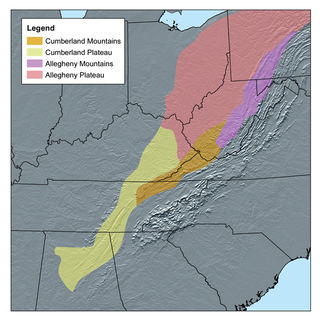
The Appalachian Plateau is a series of rugged dissected plateaus located on the western side of the Appalachian Mountains. The Appalachian Mountains are a mountain range that run down the Eastern United States. The Appalachian Plateau is the northwestern part of the Appalachian Mountains, stretching from New York to Alabama. The plateau is a second level United States physiographic region, covering parts of the states of New York, Pennsylvania, Ohio, Maryland, West Virginia, Virginia, Kentucky, Tennessee, Alabama, and Georgia.

Halesia, also known as silverbell or snowdrop tree, is a small genus of four or five species of deciduous large shrubs or small trees in the family Styracaceae.

Heuchera is a genus of largely evergreen perennial plants in the family Saxifragaceae, all native to North America. Common names include alumroot and coral bells.
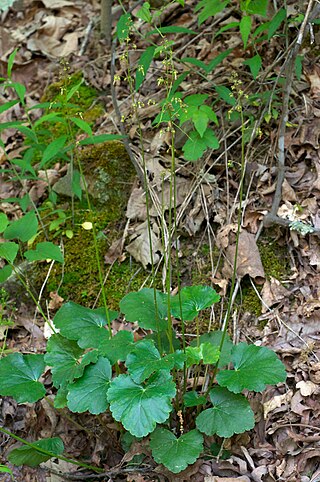
Heuchera americana, or American alumroot, is a small evergreen perennial native to eastern and central North America in the Saxifrage family.

Heuchera villosa, the hairy alumroot, is a small evergreen perennial native to the Eastern United States. It is found only on rock outcrops, growing on cliffs and boulders.

Heuchera rubescens, with the common name pink alumroot, is a species of Heuchera.

Heuchera brevistaminea is a rare species of flowering plant in the saxifrage family known by the common name Laguna Mountains alumroot. It is endemic to the Laguna Mountains of San Diego County, California. It grows in rock crevices and steep cliffsides in chaparral and yellow pine forest habitats. This is a rhizomatous perennial herb producing an inflorescence up to 25 centimeters tall. The flowers are bright pink or magenta.

Heuchera elegans is a species of flowering plant in the saxifrage family known by the common name urn-flowered alumroot.

Heuchera merriamii is a species of flowering plant in the saxifrage family known by the common name Merriam's alumroot. It is native to the Klamath Mountains of southern Oregon and northern California, where it grows on the rocky slopes. This is a rhizomatous perennial herb producing a patch of leaves which are rounded and have five to seven lobes along the edges. It produces an erect inflorescence up to about 23 centimeters tall with sparse clusters of pinkish, yellow, or cream flowers. The inflorescence is covered in glandular hairs. Each flower has small spoon-shaped petals and protruding stamens.
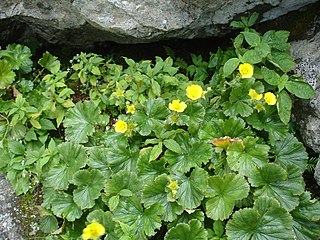
Geum radiatum is a rare species of flowering plant in the rose family known by the common names spreading avens, Appalachian avens, and cliff avens. It is native to the region of the border between Tennessee and North Carolina in the southeastern United States, where there are eleven known populations remaining. The plant was federally listed as an endangered species in 1990.
Silene seelyi is a species of flowering plant in the family Caryophyllaceae known by the common names Seely's catchfly and Seely's silene. It is endemic to Washington state in the United States, where it is limited to the Wenatchee Mountains of Chelan and Kittitas Counties.

Aquilegia laramiensis is a species of flowering plant in the buttercup family known by the common name Laramie columbine. It is endemic to Wyoming in the United States, where it is known only from the Laramie Mountains.
Heuchera eastwoodiae is a species of flowering plant in the saxifrage family, Saxifragaceae. It is endemic to Arizona in the United States, where it is found in Gila, Maricopa and Yavapai Counties. It is known by the common names Senator Mine alumroot and Eastwood alumroot.
Heuchera pulchella, the Sandia Mountain alumroot or Sandia Mountain coral-bells, is a plant species endemic to central New Mexico, mostly in the Manzano and Sandia Mountains, but cultivated as an ornamental elsewhere. It grows in canyons and on steep mountain slopes in Torrance, Bernalillo, and Sandoval Counties at elevations of 2700–3200 m.
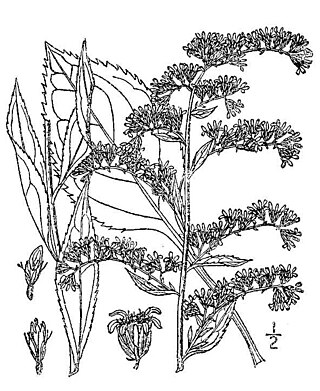
Solidago arguta, commonly called Atlantic goldenrod, cut-leaf goldenrod, and sharp-leaved goldenrod, is a species of flowering plant native to eastern and central North America. It grows along the Gulf and Atlantic states of the United States from Texas to Maine, inland as far as Ontario, Illinois, and Kansas. It is primarily found in areas of woodland openings, such as outcrops or clearings.
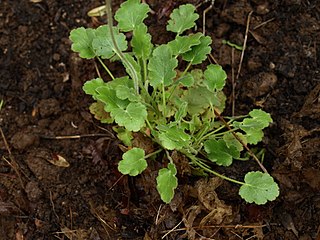
Heuchera cylindrica is a species of perennial flowering plant in the saxifrage family known by the common names poker alumroot,roundleaf alumroot, and coral bells. It is native to western North America, where it is found from British Columbia to California, and east to Wyoming and Montana.

Carex flexuosa, commonly called flexuous white-edge sedge, or Rudge's white-edge sedge, is a species of flowering plant in the sedge family, Cyperaceae. It is native to the eastern North America, where it is found in eastern Canada, the northeastern and midwestern United States, and southward in the Appalachian Mountains. Its natural habitat is in upland forests, rock outcrops, and Appalachian balds. It is typically found in areas with acidic soil.

Thaspium trifoliatum, commonly called meadow-parsnip or purple meadow-parsnip is a species of flowering plant in the carrot family (Apiaceae). It is native to eastern North America where it is found in many eastern U.S states and in Ontario, Canada. It has a broad natural habitat, which includes mesic to dry forests and woodlands, prairies, bluffs, and rock outcrops.
Heuchera caroliniana, the Carolina alumroot, is a species of flowering plant in the family Saxifragaceae, native to the US states of Virginia, North Carolina and South Carolina. Split off from Heuchera americana, which it closely resembles, it is found the northwestern and west-central Piedmont, where H. americana is largely absent. It grows in rich upland woods on base-saturated substrates, basic dikes, and basic rock outcroppings.















